
| Summary : |
![]()
Roundup : DDR-I Vs DDR-II
In this section, we will explore the differences in performance between DDR2 and DDR1. During our testing of Intel’s LGA775 platform, we had noted that DDR400 appeared slightly more powerful than DDR2-533, although the difference is not enormous. So we will examine this point further, and also will compare DDR500 with DDR2-667.
First of all, we should define the test protocol. Indeed, no motherboard allows DDR2-667 or DDR500 to function with a 200 MHz FSB. This would not be of theoretical interest anyway since the memory bandwidth would be higher than the maximum bandwidth required by the FSB, and one would find oneself in the familiar case of the nForce2 in which Dual Channel brought almost nothing. This being the case for any FSB frequency, the RAM/FSB ratio remains at 1:1. That said, the efficiency of DDR1 or DDR2 on an Intel platform being far from 100%, one could indeed benefit from this bus.
For a DDR1 vs DDR2 comparison, we chose the following platforms and configurations:
- Pentium 4 'EE' 3.0 GHz - 15*200 - i875P - Dual DDR 400 - CAS 2-2-2-5
- Pentium 4 'EE' 3.0 GHz - 12*250 - i875P - Dual DDR 500 - CAS 2.5-3-3-8
- Pentium 4 'EE' 3.0 GHz - 15*200 - i925X - Dual DDR-II 533 - CAS 3-3-3-5
- Pentium 4 'EE' 3.0 GHz - 12*250 - i925X - Dual DDR-II 667 - CAS 4-4-4-12
As you can see, we chose aggressive timings in DDR400 and DDR2-533 modes, 2-2-2-5 and 3-3-3-5 respectively, which represent the lowest for the two platforms. Then, we pushed the FSB to 250 MHz in order to obtain memory frequencies coinciding with those of DDR500 and DDR2-667. The timings are this time "average", i.e. 2.5-3-3-8 for DDR and 4-4-4-12 for DDR2. In all cases, the CPU remains at 3 GHz. Let’s start with a simple test under Sandra:
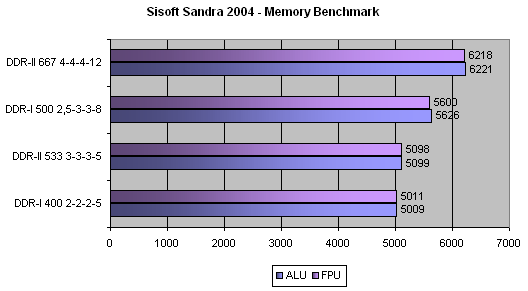
As you can see here, the DDR1-500 mode easily exceeds the results of DDR2-533, but the top of the group is unquestionably DDR2-667. Also note that with tight timings, DDR2-533 again has the advantage over DDR1-400, whereas this was not the case with looser timings. The results of the membench test of ScienceMark v2 confirm these results:
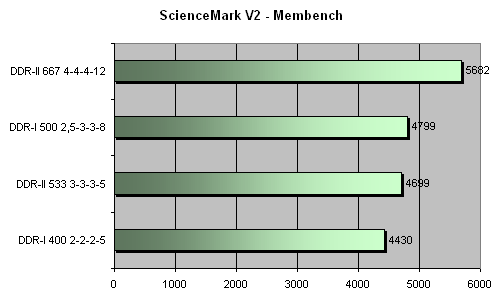
In light of these results, it seems clear that DDR2 benefits much more from a high FSB than does DDR1. Thus, the more the memory frequency increases and the more the FSB goes up the greater the performance will be, with a progression that is not linear. So one would conclude that the throughput obtained makes it possible to compensate for higher and higher memory timings. On these timings, let’s look at the results under mbench:
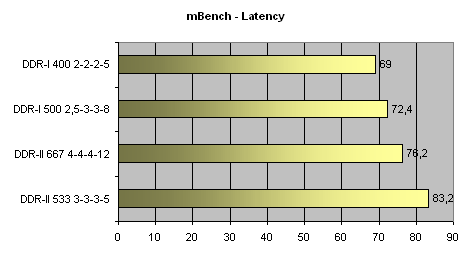
It is without question DDR1 that offers a better response time. Another fact is also noted: if the bandwidth obtained by DDR1-500 isn’t able to compensate for the higher timings, it is the case with DDR2 since the asynchronous mode in 4-4-4-12 offers a lower latency than DDR2-533 and 800FSB at 3-3-3-5. Let’s continue now with cachemem:
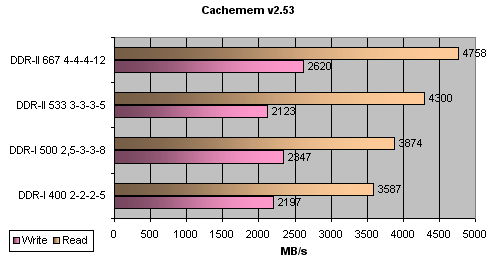
In the same respect, cachemem confirms the supremacy of DDR2-667. The gain by going from DDR2-533 to DDR2-667 is greater than the gain from DDR1-500 to DDR1-400. We’ll finish with the wstream tests:
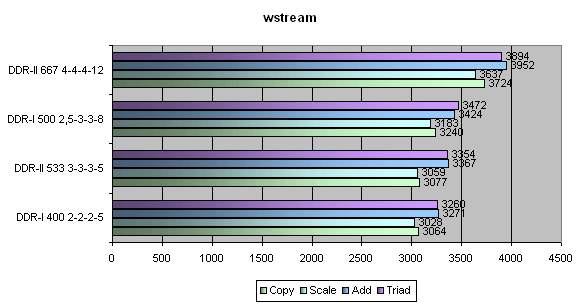
On this test, we note once again the much greater increase in the DDR2-667 mode over DDR2-533, especially compared to DDR1-500 vs DDR1-400 (you follow?). Besides, it seems, in light of these results, that the i925X is not really planned for 800FSB but that it will develop much better performance when the FSB passes to 1066 with the arrival of Pentium 4 EE Prescott in a few months.